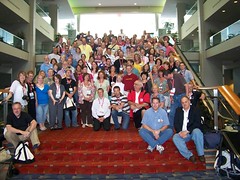
Recently I traveled to Australia, which entails, at least from my part of the world, 33 hours of travel (counting layovers and one 14 hour flight). Although I think of myself as a seasoned traveler, I worried about how I would "endure." My husband has traveled much more extensively than I have (he has only one continent left - Antarctica - before he has been to them all), his recommendation has always been to take less, not more. If he had his way, I'm sure we would have only brought enough stuff for 2 days and washed every other day, but I digress....
I had been interested in eBook readers for awhile, but this trip seemed like the perfect catalyst to see if I would really use one. Luckily, the library at my university has a lending library of eBook readers with various titles, including the Kindle & Sony reader, that I was able to use for 1 week to see if I would invest $300 in this device.
Now there have been multiple reviews of eBook readers, of the Kindle and Sony devices, of the DRM issues, etc, etc, etc. But I needed to decide what was good for me, my reading habits, my travel needs, and my bank account. In the end I settled on a Kindle, and with a few reservations it has been a truly transformational technology. And its not for the reasons I thought it would be.
 The Kindle is transformative to me because of its ease of use. Its ability to decide to read a book, and buy it within the same minute. To read a 800 page book (which I am now) while lying in bed without a neck cramp. To stop reading one book and pick up another with ease.
The Kindle is transformative to me because of its ease of use. Its ability to decide to read a book, and buy it within the same minute. To read a 800 page book (which I am now) while lying in bed without a neck cramp. To stop reading one book and pick up another with ease.And that is what makes technology transformative - when I don't really even think about using it. I just do because it makes sense. When we talk about being relevant to our teachers - this is what we mean. Technology no longer is an afterthought - but the first thought. There is no way to think of doing something without it.
Oh and as for my trip to Australia, I walked on the plane with just my purse - which had my Kindle and my iPhone (for movies and music). It was a freeing experience...










